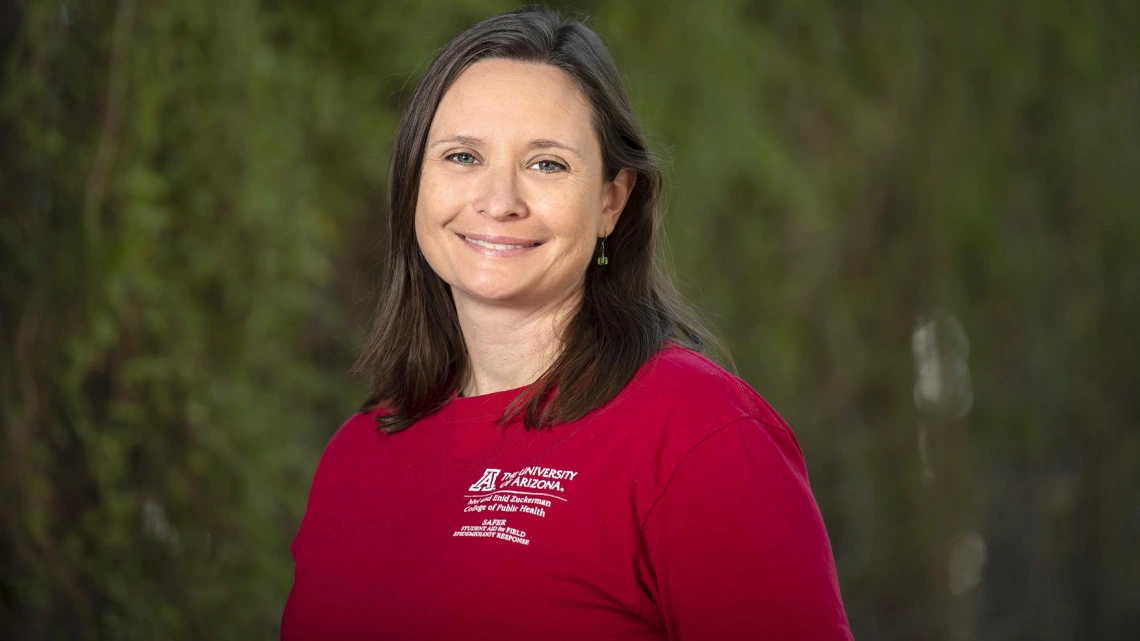Solving the COVID-19 Puzzle Energizes Research Team Member
Outbreak investigations are where Dr. Kristen Pogreba-Brown thrives.

Kristen Pogreba-Brown, PhD, MPH, a University of Arizona Health Sciences assistant professor specializing in outbreak investigations at the Mel and Enid Zuckerman College of Public Health, likens her work on COVID-19 to building an airplane in midflight. As SARS-CoV-2 rapidly spread across the world, scientists scrambled to understand the virus that set off the pandemic.
“We’re trying to build the plane while flying it, while simultaneously writing the training manual. Some of us feel like we’re doing the riveting on the outside of the plane,” Dr. Pogreba-Brown said. “From April to August, our team got an immense amount of work done, more than I would have ever thought possible.”
Dr. Pogreba-Brown is a member of the project team leading the Arizona CoVHORT study, which will follow thousands of Arizonans over the next two years, tracking who comes down with COVID-19 and how infections might trigger long-term health problems in people who recover from it. This phenomenon, which Dr. Pogreba-Brown calls “long COVID,” is poorly understood — and a study like CoVHORT could shed light on this mystery.
The project presents exciting new challenges in epidemiology.
Embarking on a unique outbreak investigation
A self-proclaimed “Wildcat for Life,” Dr. Pogreba-Brown completed her undergraduate education in microbiology at the University of Arizona, following it with a Master of Public Health and doctorate in epidemiology from the College of Public Health.

Public health graduate students support outbreak investigations by conducting telephone interviews with people who test positive for infectious diseases such as COVID-19.
Since the beginning of the pandemic, however, SAFER students have been providing “surge capacity” for overwhelmed health departments, which in addition to their regular work are inundated with reports of every COVID-19 case in the state.
“In March 2020, which feels like a decade ago for most of us, SAFER began working on case investigations for people who tested positive for SARS-CoV-2,” Dr. Pogreba-Brown said. “We were starting to hear from people who were sick for a longer period of time, getting sick and staying sick.”
Bridging infectious and chronic disease research
To unravel the mysteries presented by long COVID, the CoVHORT study is bringing together two types of epidemiologists: those who study infectious diseases and those who study chronic diseases.

CoVHORT is the first statewide long-term public health study of COVID-19.
Dr. Pogreba-Brown says a lack of patience is just part of her personality, and that she thrives on the rapid pace of outbreak investigations.
“People who do outbreak investigations are the firefighters of public health. They rush in to figure out what’s going on,” she said. “I feel like what I’m doing makes a difference quicker. It’s probably why I don’t do chronic disease, because I can’t wait 20 years for answers.”
Gathering the pieces of the puzzle
Dr. Pogreba-Brown’s interest in outbreak investigations goes back to her teen years.
“People who do outbreak investigations are the firefighters of public health.”Kristen Pogreba-Brown, PhD, MPH, assistant professor, Mel and Enid Zuckerman College of Public Health
“I remember reading The Hot Zone in high school and thinking it was amazing,” she said, referring to Richard Preston’s bestselling 1994 nonfiction thriller about Ebola virus and other highly fatal filoviruses.
“What appeals to me about outbreaks is it’s kind of like solving a puzzle,” she added. “You get pieces of information, and your job is to figure out what caused it or how you can stop it. I think it’s that puzzle aspect and that problem-solving aspect that draws most people.”
The virus that causes COVID-19 has enough puzzle pieces to last a lifetime, but in the face of a health crisis that has so far taken more than 2 million lives worldwide, researchers need to work faster. SARS-CoV-2 is new, and without a deep well of information to draw from, health care providers have been making decisions based on an incomplete understanding of their viral foe.
“That’s the thing with an emerging disease,” said Dr. Pogreba-Brown, who is also a member of the BIO5 Institute. “We don’t have years and years of publications to look back on. The literature doesn’t say anything, because we’re building the literature as we go.”
By quickly working to build the airplane in midflight, Dr. Pogreba-Brown and her CoVHORT teammates are helping to paint a picture of COVID-19 that has been sorely needed over the past year. It’s a crisis that infectious disease epidemiologists are ready to face head on.

